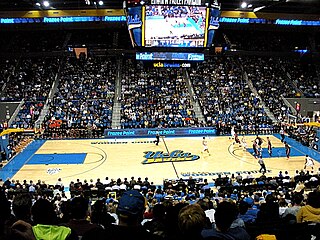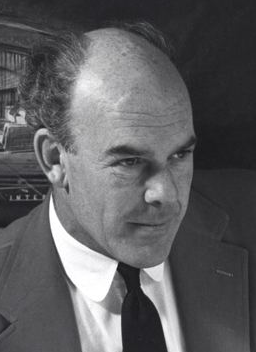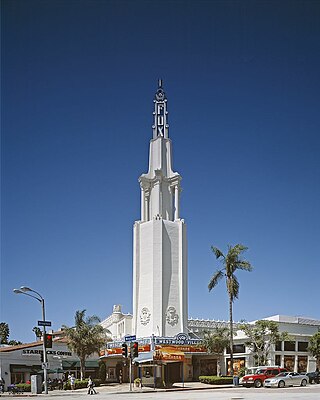
The University of California, Los Angeles (UCLA) is a public land-grant research university in Los Angeles, California, United States. Its academic roots were established in 1881 as a normal school then known as the southern branch of the California State Normal School which later evolved into San José State University. The branch was transferred to the University of California to become the Southern Branch of the University of California in 1919, making it the second-oldest of the ten-campus University of California system after the University of California, Berkeley.

Westwood is a commercial and residential neighborhood in the northern central portion of the Westside region of Los Angeles, California. It is the home of the University of California, Los Angeles (UCLA). Bordering the campus on the south is Westwood Village, a major regional district for shopping, dining, movie theaters, and other entertainment.
The Los Angeles Westside is an urban region in western Los Angeles County, California, United States. It has no official definition, but sources like LA Weekly and the Mapping L.A. survey of the Los Angeles Times place the region on the western side of the Los Angeles Basin south of the Santa Monica Mountains.

Edwin W. Pauley Pavilion, commonly known as Pauley Pavilion, is an indoor arena located in the Westwood Village district of Los Angeles, California, on the campus of UCLA. It is home to the UCLA Bruins men's and women's basketball teams. The men's and women's volleyball and women's gymnastics teams also compete here. All teams compete in the Big Ten Conference effective at the start of the 2024-25 season.

John Edward Lautner was an American architect. Following an apprenticeship in the mid-1930s with the Taliesin Fellowship led by Frank Lloyd Wright, Lautner opened his own practice in 1938, where he worked for the remainder of his career. Lautner practiced primarily in California, and the majority of his works were residential. Lautner is perhaps best remembered for his contribution to the development of the Googie style, as well as for several Atomic Age houses he designed in the late 1950s and early 1960s, which include the Leonard Malin House, Paul Sheats House, and Russ Garcia House.
"Hail to the Hills of Westwood" is the school song or alma mater of the University of California, Los Angeles. It was written by Jeane Margaret Emerson a 1929 graduate of UCLA, and adopted by the school in 1960. The current arrangement performed by the UCLA Marching Band was written by band member Dwayne S. Milburn for the 1985 football season.

The UCLA Bruins men's basketball program represents the University of California, Los Angeles in the sport of men's basketball as a member of the Big Ten Conference. Established in 1919, the program has won a record 11 NCAA titles. Coach John Wooden led the Bruins to 10 national titles in 12 seasons, from 1964 to 1975, including seven straight from 1967 to 1973. UCLA went undefeated a record four times. Coach Jim Harrick led the team to another NCAA title in 1995. Former coach Ben Howland led UCLA to three consecutive Final Four appearances from 2006 to 2008. As a member of the AAWU, Pacific-8 and then Pacific-10, UCLA set an NCAA Division I record with 13 consecutive regular season conference titles between 1967 and 1979 which stood until tied by Kansas in 2017. In 2024, UCLA departed the Pac-12 Conference and joined the Big Ten Conference on August 2, 2024.

Student housing owned by the University of California, Los Angeles is governed by two separate departments: the Office of Residential Life, and Housing and Hospitality Services, and provides housing for both undergraduates and graduate students, on and off-campus.
The University of California, Los Angeles (UCLA) traces back to the 19th century when the institution operated as a teachers' college. It grew in size and scope for nearly four decades on two Los Angeles campuses before California governor William D. Stephens signed a bill into law in 1919 to establish the Southern Branch of the University of California. As the university broke ground for its new Westwood campus in 1927 and dissatisfaction grew for the "Southern Branch" name, the UC Regents formally adopted the "University of California at Los Angeles" name and "U.C.L.A." abbreviation that year. The "at" was removed in 1958 and "UCLA" without periods became the preferred stylization under Chancellor Franklin D. Murphy in the 1960s. In the first century after its founding, UCLA established itself as a leading research university with global impact across arts and culture, education, health care, technology and more.

The Los Angeles Tennis Center is a tennis facility located on the campus of the University of California, Los Angeles in Westwood, Los Angeles, California. The center opened May 20, 1984, and hosted the demonstration tennis event of the 1984 Summer Olympics. The UCLA Bruins tennis teams moved to the facility in 1985 (men) and 1997 (women). The NCAA Women's Tennis Championships were held at the LATC in 1984, 1987, and 1988, and the Men's Championships took place there in 1997.

The Regency Village Theatre is a historic, landmark cinema in Westwood, Los Angeles, California in the heart of the Mediterranean-themed shopping and cinema precinct, opposite the Fox Bruin Theater, near the University of California, Los Angeles (UCLA). The Regency Theaters chain lease ended in July 2024. The Westwood Village Theatre has been the site for many Hollywood movie premieres in Los Angeles. The seating capacity of the cinema is about 1,400.

The Fox Bruin Theater is a 670-seat movie palace located in the Westwood neighborhood of Los Angeles, California, near University of California, Los Angeles (UCLA).

The Sheats–Goldstein Residence is a home designed and built between 1961 and 1963 by American architect John Lautner in the Beverly Crest neighborhood in Los Angeles, California, a short distance up the hill from the Beverly Hills city limit. The building was conceived from the inside out and built into the sandstone ledge of the hillside; a cave-like dwelling that opens to embrace nature and view. The house is an example of American Organic Architecture that derives its form as an extension of the natural environment and of the individual for whom it was built. Typical of Lautner's work, the project was approached from an idea and a structure was derived that addressed the challenges of the site.

Holmby Hall is an historic landmark building in Westwood Village, Los Angeles, California. Built in 1929, Holmby Hall is a streetscape of six Spanish Colonial Revival storefronts and features a prominent white clock tower, capped by a green pinnacle. The tower measures about 110 feet tall and features six levels.

Joe Bruin, an anthropomorphic male brown bear, is the official mascot of the University of California, Los Angeles’ athletic teams along with Josephine "Josie" Bruin, a female brown bear, who is his regular partner at UCLA sporting events and other university activities.

The UCLA Bruins men's soccer team is an intercollegiate varsity sports team of the University of California at Los Angeles. The team is a member of the Big Ten Conference of the National Collegiate Athletic Association.
The 1954 UCLA Bruins football team was an American football team that represented the University of California, Los Angeles (UCLA) in the Pacific Coast Conference during the 1954 college football season. They played their home games at the Los Angeles Memorial Coliseum and were coached by Red Sanders. It was Sanders' sixth season as the UCLA head coach; the Bruins finished 9–0 overall, and were Pacific Coast Conference Champions with a 6–0 record. In nine games, UCLA outscored their opponents, 367 to 40.

The Strathmore Apartments is a historic 8-unit multi-family complex located at 11005-11013 1/2 Strathmore Drive in the Westwood neighborhood of Los Angeles, California. Notable past residents, amongst others, include John Entenza, Charles Eames, Ray Eames, Luise Rainer, Clifford Odets, and Orson Welles.

The Landfair Apartments is a historic two-building multi-family complex located on the southwest corner of Landfair Avenue and Ophir Drive in the Westwood neighborhood of Los Angeles, California. They were colloquially known as The Glass House and was renamed Robison Hall after UCHA member Everett Robison was drafted and killed in action in World War II.

The University Cooperative Housing Association(UCHA) is a student housing cooperative in Westwood, Los Angeles near the University of California, Los Angeles (UCLA) campus. Able to house and feed over 400 members, the UCHA primarily offers housing to UCLA students, but welcomes members from any institution. The UCHA operates three buildings: Hardman-Hansen Hall (HHH or "Triple H"), Essene Hall, and Robison Hall. Jim Morrison of The Doors purportedly lived at the UCHA during his time at UCLA. Alongside the UCLA campus, Hardman-Hansen and Robison Halls were used as filming locations for the 1982 horror film, The Dorm That Dripped Blood. Many students of China's Lost Generation studying at UCLA resided at the UCHA.
















